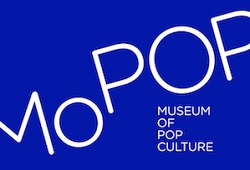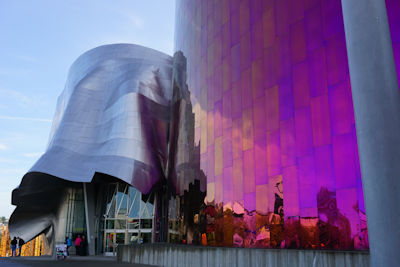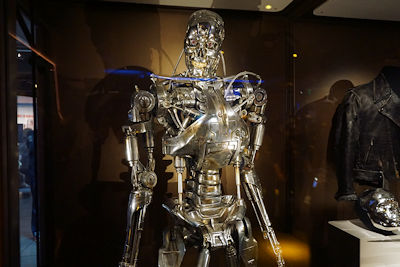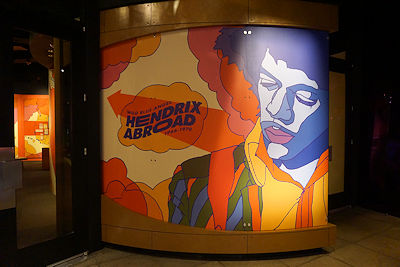
The seeds for what would become the Museum of Pop Culture were planted in May 1969 at the Seattle Center Coliseum. A young Paul Allen – who would go on to co-found Microsoft six years later – attended his first rock concert, the return of hometown hero Jimi Hendrix. Allen spent the rest of year obsessed with Hendrix, anxiously awaiting his next local performance the following summer. That appearance would be the last in Seattle for the legendary guitarist, who was found dead just a few months later.
After Microsoft took off and Paul Allen became a billionaire, his idolization for Jimi Hendrix remained and evolved from simple fan to full-fledged collector. The purchases he made weren’t meant for private viewing, however, as Allen and his sister Jody had already envisioned a Jim Hendrix museum in the hometown that each of them shared.
“As Jody and I originally conceived it, the Jimi Hendrix Museum would be a ten-thousand-square foot gallery at the Flag Pavilion, a building from the 1962 World’s Fair,” Paul Allen explained in his 2012 memoir Idea Man. It didn’t take long, though, for the two siblings to realize that just displaying a collection of clothes and guitars wasn’t representative of the vision they had – for the idea to truly work, the museum had to tell a story, one that placed Hendrix within the musical heritage of the Pacific Northwest.
As their plans evolved, so did the name of the endeavor, from Jimi Hendrix Museum to Experience Music Project in order “to imply a place that would always be dynamic, a work in progress,” Allen wrote in 2012. It would still be centered on Hendrix as the word “experience” inferred – a nod to both his band, the Jimi Hendrix Experience, as well as the album Are You Experienced – but contain a larger focus as well.
Experience Music Project would still be located at the site of the 1962 World’s Fair but instead of taking over an existing building, an entirely new facility would be built near the Space Needle. Officially announced in February 1995, the plan expanded to 140,000 square feet of museum space as opposed to the initially conceived 10,000 square foot gallery, at a cost of $250 million. Famed architect Frank Gehry was contracted to design the facility, given the sole guideline by Paul Allen to it make it “something swoopy.”
“With not a single straight line or right angle, EMP had to be one of the most complicated buildings ever designed,” Allen commented in Idea Man of the rounding shapes in contrasting metallic colors that distinguishes the building. “It had a freeform quality that evoked music, just what I’d been after. We could have made it square and gray and monochromatic, but wouldn’t that have been boring? EMP is rock-’n’-roll architecture – in your face, rebellious, larger than life. It’s exuberant and fearless, like the man (Hendrix) who inspired it.”
Experience Music Project opened its doors to the public in June 2000 and included a listening lounge where visitors could watch concert footage of everyone from B.B. King to Neil Young, a Guitar Gallery filled with 55 vintage guitars spanning over 200 years, and various gallery rooms that were not only centered on Jimi Hendrix but special sections for Eric Clapton, Bob Dylan and Janis Joplin as well.
The most popular features of EMP, however, were Sky Church and Sound Lab. Jimi Hendrix himself once referenced a Sky Church, which he envisioned as a gathering place for people to congregate and experience the joy of music. The Sky Church of Experience Music Project epitomized those plans with a large, open hall where guests could gather and relax during the day and watch live performances during the evening.
Sound Lab, meanwhile, took the popular Guitar Hero video game and made it real with jam stations, private rooms and soundproof studios that featured an assortment of actual musical instruments that visitors could not only practice with but use to record their own CD.
Just as the original idea for a Jimi Hendrix Museum evolved into Experience Music Project, EMP further evolved in 2004 to include science fiction as part of its focus. A young Jimi Hendrix was a fan of the medium in his youth – with many of his later musical compositions containing their own science fiction elements within their lyrics – and the same held true for a young Paul Allen. Thus when the Science Fiction and Fantasy Hall of Fame in Kansas City was in need of a new home, Allen jumped at the chance to relocate it to Seattle.
“Science fiction led me to wonder about parallel universes and how the wildest ideas might be possible,” Paul Allen explained in Idea Man. “Some of those notions are now seen as scientifically unattainable or financially and logistically impractical. But others, from videoconferencing to communication satellites, turned out to be sneak previews of the future. Either way, those paperbacks got me thinking about where technology might be headed. I’ve tried to repay my debt by opening the Science Fiction Museum and Hall of Fame in Seattle, the only facility of its kind in the world.”
The addition of the Science Fiction and Fantasy Hall of Fame led to a new name for the museum, with Science Fiction Museum tagged onto the end of Experience Music Project. There would be two additional name changes over the next twelve years as the once-exclusive musical emphasis expanded and the institution itself struggled to find its identity. First came the simplistic EMP Museum in 2011, which then morphed into the more inclusive Museum of Pop Culture – MoPOP for short – in 2016.
“MoPOP reflects who we are today and the future of the museum,” Museum of Pop Culture director Patty Isacson Sabee explained at the time. “Pop culture is a platform that resonates with audiences in a powerful way. And at MoPOP we provide avenues through our exhibits and programs for people to explore, learn, create, and celebrate pop culture in all of its diversity.”
Paul Allen likewise acknowledged that the new moniker was more reflective of the expansive changes that had occurred since Experience Music Project first opened in 2000. “This new naming captures the evolution of the wide set of experiences the museum has come to offer,” he said. “It has become a landmark destination and a valuable learning resource for visitors of all ages and engages passionate fans of pop culture from all over the world.”
The Museum of Pop Culture still retains its musical roots, with Sky Church, Sound Lab, Guitar Gallery, a revolving Jimi Hendrix exhibit, and Nirvana: Taking Punk to the Masses remaining as permanent features. They now share space, however, with the Science Fiction and Fantasy Hall of Fame, Indie Game Revolution, and Infinite Worlds of Science Fiction, as well as short-term temporary exhibits, many of which have been co-curated by MoPOP and later featured at other museums across the country.
The list includes Avatar: The Exhibition, Star Wars and the Power of Costume, Star Trek: Exploring New Worlds, and Marvel: Universe of Super Heroes. Suffice to say that whatever your pop culture passion may be, odds are it will be satisfied at the Museum of Pop Culture.
To quote another musical act from the 1960s, “what a long strange trip it’s been” for MoPOP – from Jimi Hendrix to Princess Leia, Captain Kirk and Captain America. It was a journey, however, that was well worth the time.
Anthony Letizia





